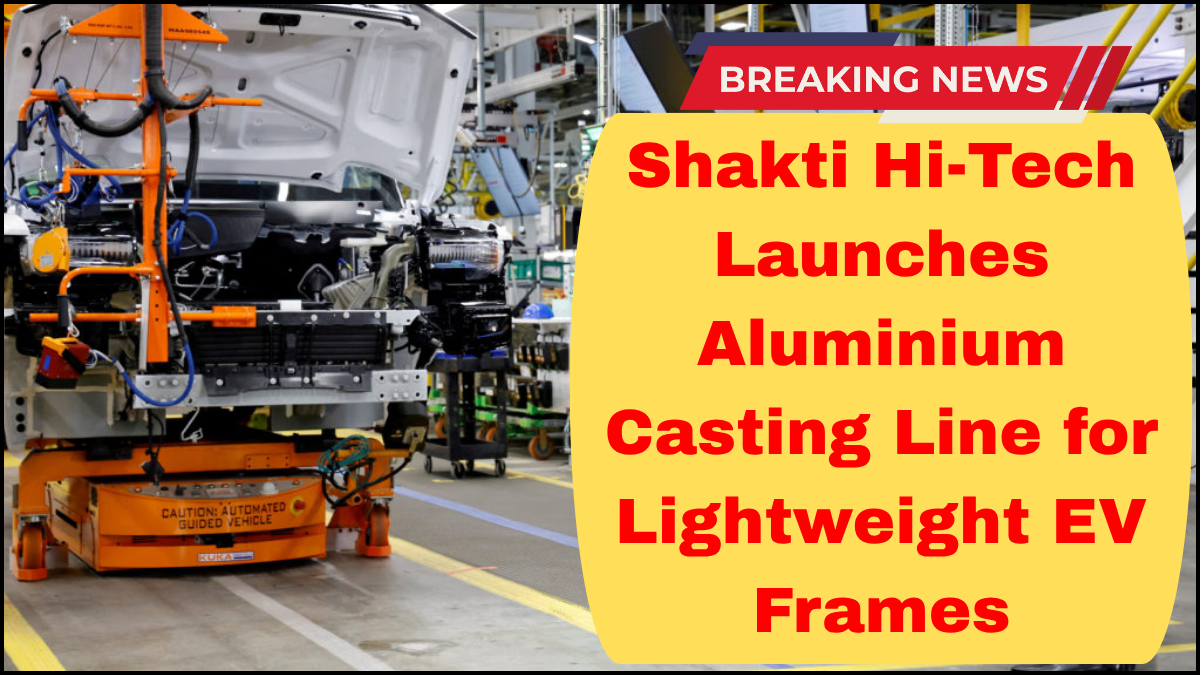Shakti Hi-Tech, a leading name in automotive manufacturing innovation, has taken a significant leap forward with the launch of its state-of-the-art aluminium casting line dedicated to producing lightweight EV frames. This strategic investment aligns with the industry’s accelerating transition toward electric mobility and underlines the company’s commitment to sustainable, high-performance manufacturing solutions.

Driving the Future of Mobility with Aluminium Casting in EVs
Electric vehicles (EVs) demand a different design and engineering philosophy compared to internal combustion engine (ICE) vehicles. Efficiency, weight reduction, and structural integrity are critical factors. Recognizing this, Shakti Hi-Tech has set up a high-precision aluminium casting facility specifically tailored to the unique needs of the EV sector.
Aluminium casting in EVs has emerged as a game-changing technology. By replacing heavier steel components with cast aluminium parts, manufacturers can significantly reduce the vehicle’s total mass. This translates into extended range, improved acceleration, and greater energy efficiency — all of which are essential for competitive EV performance.
Shakti Hi-Tech’s casting line leverages cutting-edge technologies, including high-pressure die casting (HPDC) and vacuum-assisted moulding, to produce complex, lightweight chassis components with tight tolerances and excellent surface finish. This not only enhances structural rigidity but also reduces the need for welding and assembly, thereby improving manufacturing efficiency.
Why Lightweight Chassis Components Matter in EV Design
The chassis is the backbone of any vehicle, and in EVs, it plays an even more critical role. Lightweight chassis components are not just a trend — they are a necessity. The reduced weight helps counterbalance the heavier battery packs, which are essential to power electric vehicles.
Shakti Hi-Tech’s aluminium casting line is designed to fabricate structural parts like subframes, cross members, suspension mounts, and motor housings. These components contribute directly to reducing the EV’s overall weight while maintaining crash safety standards and handling performance.
Moreover, aluminium offers natural corrosion resistance and thermal conductivity, making it an ideal material for EV applications where thermal management is critical. Shakti’s new casting facility is equipped to meet the growing demand for such precision-engineered parts.
Technological Advancements and Sustainability
What sets Shakti Hi-Tech apart is its integration of automation, real-time quality monitoring, and energy-efficient operations within its new casting line. From robotic pouring systems to AI-driven defect detection, every process has been optimized for scalability, repeatability, and minimal environmental impact.
Sustainability is embedded into the plant’s design. The aluminium used is largely sourced from recycled materials, reducing the carbon footprint associated with raw metal extraction. Water recycling, energy-efficient furnaces, and emission control systems further demonstrate Shakti’s commitment to green manufacturing.
This move not only helps the company adhere to increasingly stringent global environmental regulations but also positions it as a preferred supplier for EV manufacturers seeking sustainable supply chain partners.
Shakti’s Strategic Vision for the EV Industry
The launch of the aluminium casting line isn’t just a manufacturing upgrade — it’s a strategic step that aligns with Shakti Hi-Tech’s long-term vision to become a leading supplier of aluminium casting in EVs. The company plans to scale its output over the next five years, catering to both domestic and international electric vehicle manufacturers.
Shakti’s leadership emphasized that this facility is just the beginning. Plans are underway to integrate more advanced alloy processing and additive manufacturing techniques in the future. By staying ahead of technological trends and focusing on lightweight chassis components, Shakti Hi-Tech aims to play a central role in shaping the next generation of electric mobility.
FAQs
Q1. Why is aluminium casting important in electric vehicles?
Aluminium casting is vital in EVs because it allows manufacturers to create lightweight, durable components that improve vehicle efficiency, increase range, and reduce energy consumption.
Q2. What types of EV parts can be made using aluminium casting?
Parts such as motor housings, suspension mounts, battery enclosures, and structural chassis components can be efficiently produced using aluminium casting techniques.
Q3. How does reducing vehicle weight benefit electric vehicles?
Lighter vehicles require less energy to move, which enhances acceleration, extends battery life, and reduces charging frequency — all key performance metrics for EV buyers.
Q4. What is high-pressure die casting (HPDC), and why is it used?
HPDC is a method where molten aluminium is injected into steel moulds at high pressure, producing high-strength, precise, and complex parts with minimal post-processing required.
Q5. Is recycled aluminium used in Shakti Hi-Tech’s casting process?
Yes, Shakti Hi-Tech uses a significant percentage of recycled aluminium in its casting process, reinforcing its dedication to sustainable and eco-friendly manufacturing.
click here to learn more